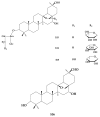Recent Advances in Biotransformation of Saponins
- PMID: 31248032
- PMCID: PMC6650892
- DOI: 10.3390/molecules24132365
Recent Advances in Biotransformation of Saponins
Abstract
Saponins are a class of glycosides whose aglycones can be either triterpenes or helical spirostanes. It is commonly recognized that these active ingredients are widely found in various kinds of advanced plants. Rare saponins, a special type of the saponins class, are able to enhance bidirectional immune regulation and memory, and have anti-lipid oxidation, anticancer, and antifatigue capabilities, but they are infrequent in nature. Moreover, the in vivo absorption rate of saponins is exceedingly low, which restricts their functions. Under such circumstances, the biotransformation of these ingredients from normal saponins-which are not be easily adsorbed by human bodies-is preferred nowadays. This process has multiple advantages, including strong specificity, mild conditions, and fewer byproducts. In this paper, the biotransformation of natural saponins-such as ginsenoside, gypenoside, glycyrrhizin, saikosaponin, dioscin, timosaponin, astragaloside and ardipusilloside-through microorganisms (Aspergillus sp., lactic acid bacteria, bacilli, and intestinal microbes) will be reviewed and prospected.
Keywords: bioavailability; biotransformation; microorganisms; saponins.
Conflict of interest statement
The authors declare no conflicts of interest.
Figures



















Similar articles
-
Constitutive beta-glucosidases hydrolyzing ginsenoside Rb1 and Rb2 from human intestinal bacteria.Biol Pharm Bull. 2000 Dec;23(12):1481-5. doi: 10.1248/bpb.23.1481. Biol Pharm Bull. 2000. PMID: 11145182
-
Chemical and metabolic analysis of Achyranthes bidentate saponins with intestinal microflora-mediated biotransformation by ultra-performance liquid chromatography-quadrupole time-of-flight mass spectrometry coupled with metabolism platform.J Pharm Biomed Anal. 2019 Jun 5;170:305-320. doi: 10.1016/j.jpba.2019.03.041. Epub 2019 Mar 28. J Pharm Biomed Anal. 2019. PMID: 30954021
-
Hydrolysis of timosaponin BII by the crude enzyme from Aspergillus niger AS 3.0739.J Asian Nat Prod Res. 2010 Nov;12(11):955-61. doi: 10.1080/10286020.2010.510470. J Asian Nat Prod Res. 2010. PMID: 21061217
-
Sources, metabolism, health benefits and future development of saponins from plants.Food Res Int. 2024 Dec;197(Pt 1):115226. doi: 10.1016/j.foodres.2024.115226. Epub 2024 Oct 22. Food Res Int. 2024. PMID: 39593311 Review.
-
Chemistry and cancer preventing activities of ginseng saponins and some related triterpenoid compounds.J Korean Med Sci. 2001 Dec;16 Suppl(Suppl):S28-37. doi: 10.3346/jkms.2001.16.S.S28. J Korean Med Sci. 2001. PMID: 11748374 Free PMC article. Review.
Cited by
-
Potential roles of gut microbes in biotransformation of natural products: An overview.Front Microbiol. 2022 Sep 29;13:956378. doi: 10.3389/fmicb.2022.956378. eCollection 2022. Front Microbiol. 2022. PMID: 36246222 Free PMC article. Review.
-
Cardioprotective Effect of Rumex vesicarius Linn. Leaf Extract against Catecholamine-Induced Cardiotoxicity.Molecules. 2022 May 24;27(11):3383. doi: 10.3390/molecules27113383. Molecules. 2022. PMID: 35684321 Free PMC article.
-
Preparation and pharmacological effects of minor ginsenoside nanoparticles: a review.Front Pharmacol. 2022 Aug 8;13:974274. doi: 10.3389/fphar.2022.974274. eCollection 2022. Front Pharmacol. 2022. PMID: 36003522 Free PMC article. Review.
-
Saikosaponin D: review on the antitumour effects, toxicity and pharmacokinetics.Pharm Biol. 2021 Dec;59(1):1480-1489. doi: 10.1080/13880209.2021.1992448. Pharm Biol. 2021. PMID: 34714209 Free PMC article. Review.
-
Notoginsenoside Ft1 acts as a TGR5 agonist but FXR antagonist to alleviate high fat diet-induced obesity and insulin resistance in mice.Acta Pharm Sin B. 2021 Jun;11(6):1541-1554. doi: 10.1016/j.apsb.2021.03.038. Epub 2021 Mar 30. Acta Pharm Sin B. 2021. PMID: 34221867 Free PMC article.
References
-
- Haralampidis K., Trojanowska M., Osbourn A. Biosynthesis of triterpenoid saponins in plants. Adv. Biochem. Eng. Biotechnol. 2002;75:31–49. - PubMed
-
- Cheeke P.R. Actual and Potential Applications of Yucca Schidigera and Quillaja Saponaria Saponins in Human and Animal Nutrition. Sapon. Food Feedstuffs Med. Plants. 2000;45:241–254.
Publication types
MeSH terms
Substances
Grants and funding
LinkOut - more resources
Full Text Sources
Other Literature Sources

